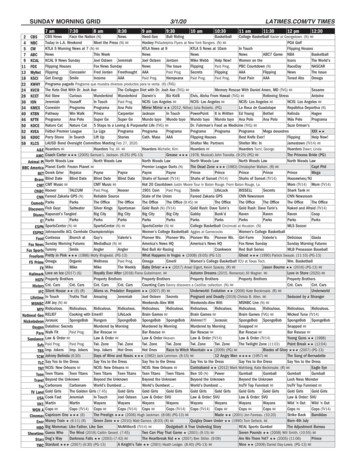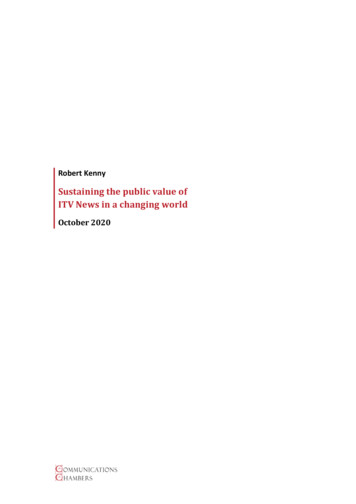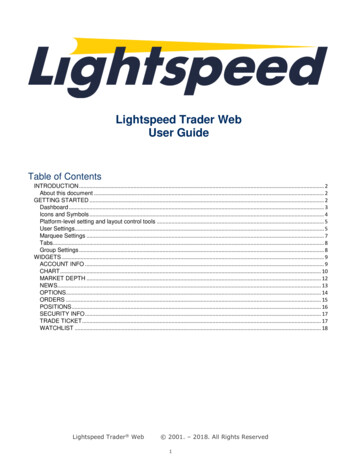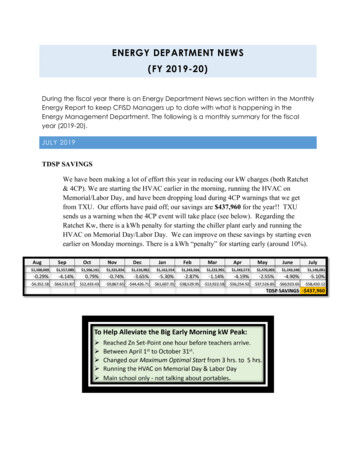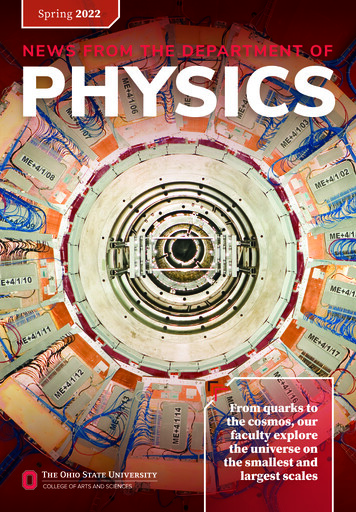
Transcription
Spring 2022PHYSICSNEWS FROM THE DEPARTMENT OFFrom quarks tothe cosmos, ourfaculty explorethe universe onthe smallest andlargest scales
The Annual AlpheusW. Smith LectureJoachim Frank, Professor ofBiochemistry and MolecularBioPhysics and Professor ofBiological Sciences, at ColumbiaUniversity will present the nextAlpheus W. Smith Lecture on March22, 2022. He was awarded the 2017Nobel Prize in Chemistry jointlywith Jacques Dubochet and RichardHenderson “for developing cryoelectron microscopy for the highresolution structure determinationof biomolecules in solution.”Fundamental processes of life are governed by a number ofcomplicated molecules. The electron microscope, which useselectron beams instead of light, expands the possibilities toimage these molecules. However, electron beams destroybiological structures. Between 1975 and 1986, JoachimFrank developed a method for analyzing and merging blurrytwo-dimensional images of the electron microscope into asharp three-dimensional image. Electron microscope imagesprovide knowledge that is important for the development ofpharmaceuticals, among other things.Joachim Frank was born in Siegen, Germany. After studiesat the universities in Freiburg and Munich, he received hisdoctor’s degree at the Technical University of Munich in1970. Frank has worked at several institutions in the U.S.and Europe, including the Wadsworth Center, New YorkState Department of Health, State University of New Yorkat Albany, Howard Hughes Medical Institute and ColumbiaUniversity, where he has remained since 2008.COVID-19 delayed the opportunityfor Donna Strickland to join us forthe 2020 Alpheus Smith Lecture,but she plans to present the lecturein September of 2022. She is a 2018Nobel Laureate for her “methodof generating high-intensity, ultra-short optical pulses”.Born in Guelph, Ontario, Canada,Strickland became interested inlaser and electro-optics early andstudied at McMaster University in Hamilton, Ontario. Shepursued her doctoral studies in the U.S. at the University ofRochester, where she did her Nobel Prize-awarded work.She obtained her PhD in 1989. She subsequently has workedat Princeton University and since 1997 at the University ofWaterloo in Canada.ON THE COVERThe pixel detector being installed at thecenter of the CMS detector at CERN.The sharp beams of laser light have given us newopportunities to deepen our knowledge about the worldand shape it. In 1985, G’erard Mourou and Donna Stricklandsucceeded in creating ultrashort high-intensity laser pulseswithout destroying the amplifying material. They stretchedthe laser pulses in time to reduce their peak power, amplifiedthem and compressed them, dramatically increasing theirintensity. “Chirped pulse amplification” has many uses,including corrective eye surgeries.Fortunately for us, on Oct. 20,2020, Sylvester James Gates Jr.was able to present the 58th annuallecture virtually. Jim Gates is atheoretical physicist who workson supersymmetry, supergravityand superstring theory. He retiredfrom the physics department andCenter for Fundamental Physics atthe University of Maryland Collegeof Computer, Mathematical andNatural Sciences in 2017, andhe is now director of the BrownTheoretical Physics Center, the Ford Foundation Professorof Physics, Affiliate Professor of Mathematics and WatsonInstitute for International Studies and Public Affairs FacultyFellow at Brown University. He was a University of MarylandRegents Professor and served on former President BarackObama’s Council of Advisors on Science and Technology.His topic for the lecture was “How Thinking Like A GeneticistHelped Me Solve A 25 Year-Old Einstein-Type Problem InString Theory.” “Imagine if the world’s smartest physicistmade a mistake in a string theory calculation, while beingobserved by aliens in a passing starship. If the aliens areto communicate a helpful comment, the Earth-boundphysicist must account for relativity and quantum theoriessimultaneously. For over two decades, the resolution to thispuzzle was unknown. Using ideas from geneticists to sortthrough 4,294,967,296 functions, a solution was found in thesummer of 2020.”In the afternoon, we were honored to have Jim present“My Journey Thinking About Racism & STEM Disciplines”with the Departments of Physics and Astronomy. “Theworldwide response of moral revulsion triggered by thebroad dissemination of a video showing the extrajudicialexecution of George Floyd (as the crescendo to far too manysuch occurrences) has compelled even the organizers of the‘Strings 2020’ conference to engage me in this conversationfor their global cyberspace attendees. Thus, I feel a duty torespond.” The Alpheus Smith Lecture has been bringing leading-edgework of Nobel Laureates and other prominent physicists to thecommunity since 1960. The free, public lecture series is endowedby Robert Smith to honor his father, Professor Alpheus W. Smith.Letter fromthe ChairI am delighted to provide anintroduction to the 2021 edition ofthe Physics Magazine. But first let meintroduce myself. I started as chairat the beginning of July in 2020. Ihave been a member of our physicscommunity since 2006. My researchprogram is in the field of experimentalbiophysics, and since I started mylaboratory, we have been workingto understand how the physicalproperties of the human genomeregulate gene expression using singlemolecule methods. Then, about 8years ago, we expanded into the fieldof DNA nanotechnology where we aredeveloping DNA nanodevices for celland molecular biology applications.It is an honor to serve as chair of oneof the top physics departments inthe country. Our department has awonderful community of world - classfaculty, staff, postdocs, graduateand undergraduate students that areworking together to make cutting edgediscoveries in a wide range of physicsand to educate the next generation ofscientific leaders.Of course, these past 2 years havebeen a period of unique challengesbecause of the COVID-19 pandemic,which started at the beginning of2020 soon after the last edition of thePhysics Magazine came out. While thechallenges were numerous, it has beentruly amazing how the departmentcame together to solve challenge afterchallenge to allow us to continueour outstanding instruction andcutting-edge research programs. I amparticularly grateful to the previouschair, Professor Brian Winer, who ledthe department during the beginning ofthe pandemic, and to our outstandinggraduate teaching assistants andlecturers, who were so essential to usproviding laboratory instruction duringthe pandemic. For more details on howthe department adapted during thepandemic, please read the article in thisPhysics Magazine, “The departmentresponds to COVID.”Our research programs continueto be highly successful. Articles inthe magazine provide a glimpse intothe numerous research successeswe have had over the past couple ofyears. We continue to expand ourresearch output and funding and areone of leading institutions in grantingboth undergraduate and PhD Physicsdegrees. These numbers are listed inthe magazine.TABLE OFCONTENTSThe DepartmentResponds to COVID . pg. 2A key focus of the department is tomake meaningful and lasting changeon both race and gender diversity,equity and inclusion in our department.Some highlights are the department’sBridge Program to help studentstransition from their undergraduatestudies to graduate school, the POLARISmentoring program for first yearundergraduate students, the URSAprogram and the American PhysicsSociety Inclusion, Diversity, andEquity Alliance (APS-IDEA). Diversity,equity and inclusiveness are essentialparts of excellence in all areas of thedepartment. Physics is inherently ateam endeavor and diverse teams arebetter at solving problems — whetherthis is part of group work in a class orresearch group solving unansweredproblems at the forefront of their field.I would like to thank everyone in ourphysics community for their effort andsupport. I am so very proud to be apart of such a vibrant and successfuldepartment.I hope you enjoy reading aboutmany of the great successes andaccomplishments over the past coupleof years.Sincerely,Michael PoirierResearch . pg. 4- High energy DOE grant pg.4- QuSTEAM initiativeawarded 5 million pg.6- Center for EmergentMaterials awarded 18 million pg.8- Does Columbus haveenough tall buildingsto support Spider-Man? pg.9- Scientists harness chaosto protect devices fromhackers pg.10- The universe is gettinghot, hot, hot pg.11- NSF NeXUS workshoppg.12- Thermal chiral anomalyin the magnetic-fieldpg.13- A new way to detectsubatomic particles fromdeep spacepg.13- DESI project beginsoperationpg.14Undergraduates . pg.14Diversity, Equityand Inclusion . pg.16- Estefany Nunez Ornelaspg.16- URSA Programpg.16- APS-IDEApg.17- Dr. Beatriz E. BurrolaGabilondopg.17- The STEMcoding Projectpg.17Alumni & Support . pg.18Physics bythe Numbers . pg.20Faculty News . pg.201
With the dramatic onset of the COVID-19pandemic in March 2020 the Department Safetyand Infrastructure Committee (S&I) took on anuncharacteristically urgent and critical role indepartment operations. Typically, this committeedoes not meet over the summer, and handoffbetween committees for subsequent years occursat the beginning of fall semester. But in 2020 thecommittee met continuously (often several times aweek) during the university-wide shut down and overthe summer in order to help shape the departmentresponse to these unprecedented events. The2019-2020 committee agreed to serve through the2020-2021 academic year to provide continuity andled the development of a safety plan that wouldallow for the resumption of research activities underpandemic conditions. This included providing atemplate for experimental research groups to use indeveloping masked and socially distanced operatingprotocols as well as holding a number of town hallmeetings throughout the summer with faculty,students, and staff to discuss how to work safelyin the era of COVID. The department communityresponded with an impressive show of unity andcollective action, leading to an exceptionallyeffective response that made the Department ofPhysics a model for pandemic response aroundcampus. Professor Ezekiel Johnston-HalperinThe departmentresponds to COVIDBY MICHAEL POIRIERThe response and adaption to the COVID-19 pandemic hasbeen a major focus of the department since the spring of2020. The previous department chair, Brian Winer, led thedepartment during the early months of the pandemic. Thisstarted with the abrupt transition to completely onlineclasses after the 2020 spring break. Soon after, all researchlabs were shut down and essentially all instruction, researchand administration operations were converted to beingfully remote. This took a tremendous amount of effortwith everyone working together. While there were a lot ofchallenges this was done successfully under Brian Winer’sleadership.On March 17, 2020, I sat down in the chair’s officeand began reading my email. One of the first itemswas a message from then-Ohio State PresidentMichael Drake. It said every employee that couldwork from home should start doing so immediately.The pandemic’s effects hit slowly at first as springbreak was extended an extra week. But by midMarch, the effects had gained speed, and a hugeshift in operations was required. The questionswere plentiful. How do we transition all our classesonline? What about the laboratory courses? Howare we going to continue our research? Is therecritical infrastructure in the research labs that mustbe maintained and protected? For those that needto come to campus, how do we keep them safe?What about personnel located at remote locations— do we need to get them home? These problemsrequired an all-hands-on-deck approach. The Safetyand Infrastructure Committee would be critical forestablishing new safety protocols. A new TeachingTask Force would address the challenges withinstructional delivery. The department faculty andstaff were rallying, but everyone was dealing withuncertainty about the future. We were experiencingsomething that hadn’t happened in a century. Brian Winer, ChairOnce we got through the spring 2020 semester, we continuedour summer instruction in a completely online format. Wealso began the process of planning for delivering instructionduring the 2020-21 academic year. An Instructional TaskForce with both faculty and staff was established that wasco-chaired by Professors Tom Gramila and Andrew Heckler,to plan on instruction for the fall of 2020. The teaching staffplayed key roles in both delivering instruction online duringthe summer 2020 term and planning for the fall 2020. One2Directional lanes and stay-out zones were created toensure pedestrians maintained social distance whenwalking through the atrium.of the largest challenges was to determine how to deliverlaboratory instruction safely. Some of the labs were deliveredonline (Jim will describe this), while many of our labs weredelivered in a hybrid mode where some students were inperson, and some were remote. The in-person portion ofthese hybrid laboratories were particularly challenging todeliver. The department is extremely grateful to the graduateteaching assistants in the department who delivered manyof the in-person labs. They were key to the departmentproviding an in-person laboratory experience during theworst periods of the pandemic.Another key challenge was operating research programswhile everyone was required to work remotely from Marchto July. Research programs that did not require access tolaboratory space were able to proceed relatively unimpeded.However, research that required in-person laboratory workessentially stopped for about 4 months. During this period,experimentalists focused on manuscript writing, planningfuture experiments and reviewing literature. This period wasvery disruptive for graduate students and postdocs who werein the middle of their experimental research projects. In July,the labs began to reopen at a very limited capacity. Reopeningof the Physics laboratories was guided by the Safety andInfrastructure Committee. This committee was spectacularin managing the reopening of the labs.With the evacuation of campus, multiplecountermeasures were needed for research facilitiesand department operations. New systems to handlemail, package deliveries, hazardous waste disposal,contactless pickups and other logistics werequickly created and implemented. Lab equipmentwas idled or completely shut down. Systems thatcould not be shut down were left in a minimumoperating state but required tending. A teamconsisting of operations, research and computingstaff was formed and charged with conducting dailyinspections to avoid equipment damage.A desperate call for personal protective equipmentcame from the Wexner Medical Center, and theDepartment of Physics marshalled resources andmade a robust response offering numerous gloves,gowns, face shields, wipes and isopropyl alcohol.An overflowing truckload was delivered to the dropoff, where personnel remarked that the delivery wasamong the largest donations they received fromanywhere on campus.A major effort to create new safety protocols inresponse to each of the shutdown stages wasphased in from the initial closure to the controlledreopening. The resulting protocols were informedby careful analysis of area densities and volumetricair flow versus room volumes. Signage was obtainedor created and installed throughout the facility todirect and instruct occupants on how to move aboutthe facility if and when they entered. Common-areafurniture was relocated and taken out of service toprevent gatherings. An entry monitoring programwas put in place to track unauthorized entries intothe building so corrective actions could be made. Phil Davids, Facilities Operations ManagerWhen COVID hit in the spring semester of 2020, a lot ofchanges happened quickly in our physics courses. In short,almost everything went online for the remaining monthor so of class: lectures, recitation, testing, even labs. Greateffort and patience on the part of instructors and studentsalike helped us through. In May 2020, then chair BrianWiner assembled an instructional task force of faculty andlecturers to “consider instructional issues related to thedelivery of physics courses in the next academic year.” Weused lessons learned from the spring and the summer (whichwas completely online) to craft a hybrid of online vs. inperson learning experiences for the students. In autumn 2020and spring 2021, lectures were live and online for almost allupper and lower-level courses. For the introductory courses,recitations had interactive groupwork via zoom rooms withfour students per room working in groups. With carefulplanning and special TA training, these sessions went well— students were engaged and learning much like in-personrecitation group work. Intro labs were in person, though forpurposes of distancing and safety, only one person (rotating)from each group came in each week to manipulate the labmaterials, while the rest of the group observed, recordeddata, and communicated via zoom. In some cases, whennecessary, labs were done via recordings of phenomena bythe staff and faculty, and students could record the data andmake reports. In all, the labs seemed to work, though ofcourse everyone was looking forward to going back to inperson.The transition to online delivery was particularlychallenging for our senior advanced laboratorycourse, Physics 5700. I developed a take-homekit with a USB oscilloscope, breadboards andcomponents that enabled students to conductexperiments on their own at home. Worldwideshortages of necessary items required procurementfrom sources as far away as Australia. Hands-onexperiments on RLC circuits and Johnson noise weredeveloped. In addition, Margie Farrell recordedvideo data for the Millikan Oil Drop experimentthat the students analyzed at home. Professor ChrisHammel and course staff Margie Farrell and JesseMartin tested the content developed for the lab, andthe team delivered the course fully online in Fall2020. Professor James BeattyIn the autumn of 2021, things were a little moreback to normal. The main components that werevia zoom are now the introductory course lecturesessions. Recitations, labs and upper-level coursesare back to in-person. One benefit occurring fromthis pandemic is that we have learned to use theadvantages of electronic submission of assignmentsand tests. The tests are still in-person, but thework is uploaded online by the students in class.Modern software then allows for more efficient andeffective administering and grading of tests andassignments. We are grateful to the faculty and stafffor their dedication and efforts in this pandemic,the patience and hard work of the students, and weare continually seeking ways to improve studentlearning and the student experience in these tryingtimes. Professor Andrew Heckler3
During the summer of 2020, the department chair positiontransitioned from Brian Winer to Michael Poirier. ProfessorWiner started working with Professor Poirier in May 2020to facilitate a smooth transition, which officially occurredJuly 1, 2020. Poirier continued the Teaching Task forceduring the 2020-21 academic year. He also established aCOVID Taskforce that was comprised of the DepartmentChair (Michael Poirier), Administrative Manager (Jean Ball,Nicola Betts), Facilities Operations Manager (Phil Davids), thethree Vice Chairs (Jon Pelz, Tom Humanic, Tom Gramila),the IT Systems Manager (Bryan Dunlap), the CommitteeChairs from Climate & Diversity and Safety & Infrastructure(Jay Gupta, Ezekiel Johnston-Halperin), and the Assistantto the Chair (Ruth Leonard). This committee met weeklythroughout the 2020-21 academic year to identify andrespond to numerous challenges related to the pandemic.Examples of challenges included managing shipping andreceiving when the front office was not open, obtaining PPEfor the department, providing IT support for the new modesof online instruction, providing guidelines for access tooffice space, and many more. Overall, this group was key inallowing the department to identify and respond to the widerange of issues that emerged.In the spring of 2021, vaccinations became available tostudents, faculty and staff, which coincided with a drop to alow level of COVID cases during the summer of 2021. Duringthis period the rules on social distancing were removed.There was even a brief period during the summer whenmasks were not required in doors. During this period therewas optimism that we were near the end of the pandemic.The summer of 2021 we planned for a largely normalacademic year where all courses with less than 100 studentswould be in person. Of course, the Delta variant emerged,and the cases rapidly rose back to very concerning levels.Before the beginning of the 2021-22 academic year, maskbecome required indoors and then the university mandatedvaccinations for all students, staff and faculty.Since the beginning of the 2021-22 academic year, thedepartment has opened up significantly. Classes have largelybeen in person during the fall 2021 and in spring 2022. TheDepartment Covid Taskforce still meets when required. Thedepartment has truly outstanding staff. We are trying to finda balance between staff working remotely and in person sothey can continue to be highly effective while allowing staff toleverage their experience with working remotely so they canhave more flexibility. We have a mix of in person and remotecolloquiums. In person student meetings have restarted. Staffin the department typically have a hybrid work schedule.However, many activities continue in hybrid or fully onlinesuch as faculty meetings and research group meetings. Thereis a clear desire by many in the department to have more inperson social events but there remains a wide range of safetyconcerns. So, the department is working to hold more socialevents as we progress through the 2021-22 academic year.Overall, the department has continued its excellence in ourresearch and instruction missions throughout the pandemic.We have worked to adapt to the evolving conditions, whichwill likely continue for some time. While the pandemic hasbeen one of the most challenging periods for the department,it has also been a time for the department to come togetherand demonstrate that it can work together to overcomeunprecedented changes and adversity. The department is ontrack to emerge from the pandemic stronger than ever.4RESEARCHHigh energyDOE grantFrom quarks to the cosmos – physicsdepartment faculty explore the universeon the smallest and largest scales.They study the fundamental buildingblocks of nature using CERN’s LargeHadron Collider (LHC), the largestscientific apparatus ever built. They usemountain top observatories to cataloguemillions of galaxies to understand theevolution of the cosmos influencedby dark matter and dark energy. Theydevelop important theoretical insightto explain the observations we make.In 2020, a group of department facultywere awarded a four-year 7.9 milliongrant from the U.S. Department ofEnergy to fund their efforts in theseimportant areas.Experimental faculty members(Professors Boveia, Gan, Hill, Kagan,Winer) play important roles in theLHC’s two general purpose detectors(ATLAS, CMS). On ATLAS, Boveiaperforms searches for hypotheticalparticles connected to astrophysicaldark matter and develops novel triggercapabilities, with a particular focuson applications of machine learning.Gan searches for exotic long-livedresonances that decay into leptonpairs. In addition, Gan is leading theeffort in fabricating a new generation ofoptical modules to receive and transmitoptical communications for the ATLASpixel detector. Kagan searches forsignals of di-Higgs decays and is aleading contributor in the design andfabrication of a diamond luminositymonitor and beam abort system toprotect the silicon pixel and stripdetectors at the ATLAS experiment.The effort on the CMS Experiment at theLHC is led by Professors Hill and Winer.They are developing new experimentalmethods for the High Luminosityrunning of the LHC, scheduled tobegin later this decade. Hill is helpingdevelop a new forward pixel detectorto provide high-precision chargedparticle tracking for the future CMSdetector while Winer is contributingto the development of a new triggersystem. The group uses the current datato search for extensions to the StandardModel by hunting for unusual longlived particles and applying effectivefield theory techniques in events withtop quarks.A.B.The Cosmic Frontier group, ProfessorsHonscheid and Martini (Astronomy),continues to focus on the excitingmystery of cosmic acceleration, whichis attributed to an unknown darkenergy. The group contributed to thedata analysis from the Dark EnergySurvey, which uses exquisite imagesof the night sky to measure the matterdistribution in the universe. Theseresults agree extraordinarily well withthe standard model of cosmology.The group has taken leading roles inthe recent completion of the powerfulDark Energy Spectroscopic Instrument(DESI). DESI has now begun a fiveyear survey of 35 million galaxies andquasars to obtain the most precisemeasurement of cosmic acceleration.A solid theoretical framework playsan important role in furthering ourunderstanding of the universe. Thetheory effort in particle physics is ledby Professors Braaten, Carpenter,Mathur and Raby, who explore someof the most interesting questions inthe field ranging from physics beyondC.the current standard model, to whatis inside a black hole, to the nature ofdark matter. Braaten uses effective fieldtheories to further our understandingof Quantum Chromodynamics andhow it impacts the formation of exoticheavy hadrons. Raby and Carpenter areworking on physics beyond the StandardModel, including supersymmetry,grand unified theories, dark matter andbaryogenesis. Mathur used the “fuzzballparadigm” to resolve the informationparadox of blackholes and is now usingthis paradigm and string theory toexplore its impact on our understandingof cosmology.A. Installation of the CMS pixeldetector at CERN.B. Ohio State physicists who are partof the ATLAS Collaboration.C. Graduate student Kai Wei testingthe ASIC that has been developed forthe CMS TFPX detector as part of theHL-LHC upgrade.The grant from the DOE allowsdepartment faculty to probe deeperinto the structure of the universe at themost extreme scales. The funds providethe opportunity to train young scientistsfor the next generation by supportinggraduate students and postdocs.The young scientists are trained inthe latest techniques of computers,electronics, data mining and theoreticalapproaches.5
from over 20 universities, national laboratories, communitycolleges, and historically Black colleges and universities(HBCUs) to develop a research-based quantum educationcurriculum and prepare the next generation of quantuminformation scientists and engineers. The initiative also hasover 14 industrial partners, including GE Research, Hondaand JPMorgan Chase, and collaborates with leading nationalresearch centers to help provide a holistic portrait of futureworkforce needs.“We have leaders in quantum information and STEMeducation, and both of these groups independently do goodwork building undergraduate curriculum, but they actuallywork together surprisingly rarely,” said QuSTEAM leadinvestigator Ezekiel Johnston-Halperin, professor in theDepartment of Physics at Ohio State. “We are talking to peoplein industry and academia about what aspects of quantuminformation are most critical, what skills are needed, whatworkforce training looks like today and what they expect it tolook like a couple years from now.”Ohio State-ledQuSTEAM initiativeawarded 5 millionfrom NSFMULTI-INSTITUTIONAL PROGRAMWILL DEVELOP A RESEARCHBASED QUANTUM EDUCATIONCURRICULUMA multidisciplinary, multi-institutional program led by TheOhio State University is taking the next step in its aim todevelop a diverse, effective and contemporary quantum-readyworkforce by revolutionizing and creating more equitablepathways to quantum science education.QuSTEAM: Convergence Undergraduate Education inQuantum Science, Technology, Engineering, Arts andMathematics, was awarded a 5 million cooperativeagreement over a two-year period from the National ScienceFoundation’s (NSF) Convergence Accelerator. FollowingQuSTEAM’s initial assessment period, Phase I, the award willfund Phase II’s objective to build transformative, modularquantum science degree and certification programs.“I know from personal experience that collaboration is the keyto scientific success. Working across disciplines – especiallywhen it comes to the highly complex and multidisciplinaryworld of quantum science research – will help us morequickly harness the enormous power of this emerging fieldand deliver real-world results more quickly and efficiently,”6said Ohio State President Kristina M. Johnson. “As an addedbonus, this project enables Ohio State to further part of itscore mission, which is to educate the next generation ofresearchers through educational opportunities that advancediversity and workforce development.”The rapidly evolving field of quantum information science willenable technological breakthroughs and have far-reachingeconomic and societal impacts — what researchers at theNational Institute of Standards and Technology refer to asthe second quantum revolution. Ohio State is emerging as akey leader in pushing the field forward, recently joining theChicago Quantum Exchange, a growing intellectual hub forthe research and development of quantum technology, as itsfirst regional partner.“NSF’s Convergence Accelerator is focused on acceleratingsolutions toward societal impact. Within three years, fundedteams are to deliver high-impact results, which is fast forproduct develop
the Physics Magazine. But first let me introduce myself. I started as chair at the beginning of July in 2020. I have been a member of our physics community since 2006. My research program is in the field of experimental biophysics, and since I started my laboratory, we have been working to understand how the physical properties of the human genome



